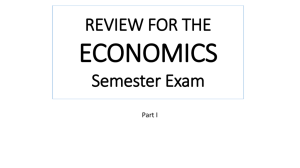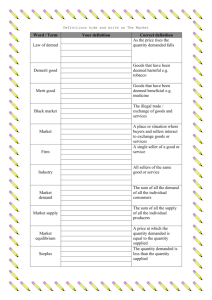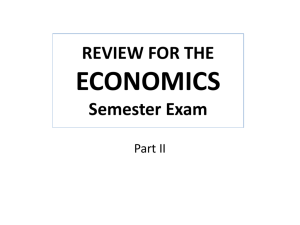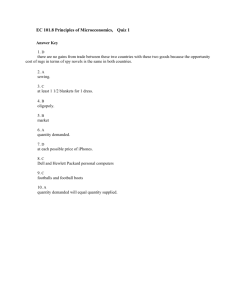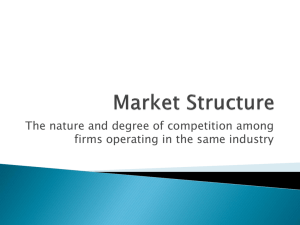REVIEW FOR THE ECONOMICS END OF COURSE TEST
advertisement
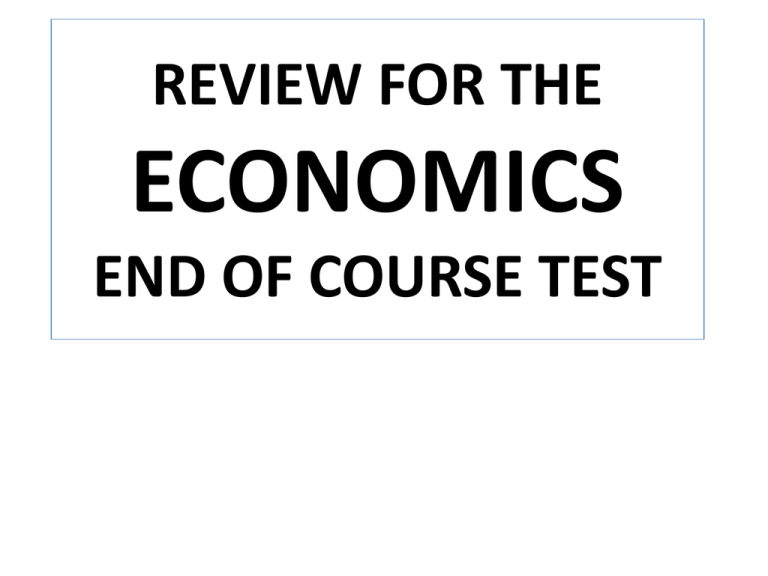
REVIEW FOR THE ECONOMICS END OF COURSE TEST REVIEW FOR THE ECONOMICS END OF COURSE TEST INSTRUCTIONS: Go through the slides and answer each question in the packet; the slide numbers are listed for each question The combination of unlimited wants and limited resources combine to cause scarcity “Opportunity cost” is the next best alternative and a “tradeoff” is an alternative that must be given up when one choice is made rather than another The difference is that there can be multiple tradeoffs when making a choice, but only one option can be the “next best alternative” LAND: any gift of the Earth (such as trees, animals, plants, water, metals, etc.) LABOR: work done by a person (for example, installing a window on a house) CAPITAL: any good used to make another good (for example, factories and equipment) ENTREPRENEUR: a person who comes up with the idea to combine the productive resources What to produce? How to produce? For whom to produce? “Marginal benefits” are the extra benefits gained by taking an action “Marginal costs” are the extra costs from taking an action If the marginal benefit exceeds the marginal cost of the action, it is the rational decision to take the action If the marginal cost exceeds the marginal benefit, the action should NOT be taken The production possibilities curve is a graphical representation of the concept of opportunity cost; it shows how much of one item must be given up in order to obtain a certain amount of the other item An example of “specialization in the workplace” is the person who attaches tires to the car in a car factory “Voluntary, non-fraudulent exchange” is trade between individuals, businesses, and/or governments that is done willingly and without any deceit A traditional economy answers the basic economic questions through customs and past practices A command economy answers the basic economic questions through a central bureaucracy A market economy answers the basic economic questions through the coming together of buyers and sellers in the marketplace A command economy has the MOST government regulation A market economy has the LEAST government regulation Economic freedom is the ability to make choices that affect your economic well-being Economic security is the protection from adverse economic effects Economic equity is the knowledge that everyone has a chance to achieve their economic goals Economic growth is the ability to make yourself better off in life and possess more material goods Economic efficiency is the wise use of economic resources Economic stability is knowing that prices and employment are not going to change drastically A public service or good are services or goods that are paid for and consumed collectively The government provides them because they are generally not profitable to produce in the private sector The government redistributes income through welfare and entitlement programs, such as Social Security and Medicaid The government protects property rights through the enforcement of contracts in the court system The government resolves market failures through regulations, legislation, and the providing of public goods and services Government regulation affects consumers and producers by limiting what is produced, how it is produced, or for whom it is produced Examples: narcotics are illegal to produce; child labor is illegal; certain products (like tobacco) cannot be sold to children “Productivity” is the amount of output produced with a given amount of productive resources Investments, improved equipment, and technology increase economic growth; as businesses become more productive, they are able to lower marginal costs of production, leading to greater efficiency in production Three examples of investment in human capital are (1) training, (2) education, and (3) healthcare Investing in human capital leads to economic growth because as people become more productive, it lowers marginal costs of production, which leads to greater efficiency in production THE CIRCULAR FLOW OF THE ECONOMY Money flows from the households to the product market in exchange for goods and services Money from the product market flows to businesses that pay for productive resources in the factor market Money from the factor market is taken to households in exchange for those productive resources Money serves as a medium of exchange because it is accepted by all parties as payment for goods and services LAW OF SUPPLY: Price and quantity supplied are directly related: as price rises, so does the quantity supplied rise; as price falls, so does quantity supplied fall LAW OF DEMAND: Price and quantity demanded are inversely related: as price rises, quantity demanded falls; if price falls, quantity demanded rises Buyers and sellers come together in the market When price is too high, quantity demanded is lower than quantity supplied, so price tends to fall into equilibrium If price is too low, a shortage will cause price to rise until equilibrium is reached SUPPLY CURVE AND DEMAND CURVE WITH EQUILIBRIUM POINT Prices serve as incentives in a market economy because prices indicate to producers what to produce and to consumers what to purchase SIX DETERMINATES OF DEMAND: (1) Consumer income (2) Consumer tastes (3) Price of compliments (4) Price of substitutes (5) Consumer expectations (6) Number of consumers FACTORS THAT CAN AFFECT THE SUPPLY CURVE: (1) Cost of resources (2) Productivity (3) Technology (4) Taxes (5) Subsidies (6) Expectations (7) Government regulations (8) Number of sellers SUPPLY AND DEMAND CURVE WITH A PRICE CEILING This will cause a shortage due to quantity demanded exceeding quantity supplied SUPPLY AND DEMAND CURVE WITH A PRICE FLOOR This will cause a surplus due to quantity supplied exceeding quantity demanded Price elasticity is the responsiveness of consumers to a change in price; it answers the question: does a change in price cause a small, large, or proportional change in quantity demanded? When demand is elastic, a small change in price will have a large change in quantity demanded When demand is inelastic, a small change in the price will have the effect of a small change in the quantity demanded ADVANTAGE and DISADVANTAGE: Sole Proprietorship ADVANTAGE: there is easy entry into the market; you are in business for yourself DISADVANTAGE: unlimited liability; limited lifespan for the company; more difficult to rise capital ADVANTAGE and DISADVANTAGE: Partnership ADVANTAGE: easier to raise capital; each partner can bring their areas of expertise into the business DISADVANTAGE: unlimited liability; limited life for the company; possible conflicts between partners ADVANTAGE and DISADVANTAGE: Corporation ADVANTAGE: least difficult to raise capital; unlimited life for the company; limited liability DISADVANTAGE: double taxation of the both the corporation (which is considered a legal entity) and the people in it The chief purpose of business is to maximize profit FIVE CHARACTERISTICS OF PURE COMPETITION (1) Identical goods (2) Large numbers of buyers and sellers (3) Buyers and sellers act independently (4) Well-informed buyers and sellers (5) Buyers and sellers are free to enter the market, conduct business, and leave the market In a MONOPOLISTIC competition, the one characteristic of a pure competition that is missing is identical goods; monopolistic competition has a differentiated product, although it may seem to be the same thing. An example: pizza places or restaurants. Even if they are all Italian restaurants, they still have their own chefs, recipes, etc. An oligopoly is a market structure with few large sellers (example: cell phone companies) A monopoly is a market structure with only one seller (example: Microsoft was accused of trying to have a monopoly over the computer industry) The equation for G.D.P. is GDP = C + I + G + (X – M) C = consumer sector I = investment sector (businesses) G = government sector (X – M) = exports minus imports; you may also substitute in Nx (net exports), N (net exports), or F (foreign sector) Gross Domestic Product is the total of all goods and services produced within a country’s borders within a given time period Economic growth is defined as an increase in a nation’s total output of goods and services over time Unemployment can be defined as the state of working less than one paid hour per week while looking for paid employment The Consumer Price Index (CPI) is used to measure price changes for a market basket of frequently used consumer items Inflation is a general increase in price levels Stagflation is inflation coupled with a lack of economic growth “Aggregate supply” is the total value of all goods and services all firms would produce in a specific period of time at various price levels “Aggregate demand” is the total value of all goods and services demanded at different price levels Economic growth is calculated through increases in real GDP over time Inflation is calculated by dividing the CPI for the current year by the CPI for the base year Unemployment is calculated dividing the total number of unemployed people by the total number of people in the civilian labor force “Structural” unemployment is unemployment that is caused by fundamental changes in the economy “Cyclical” unemployment is unemployment that is caused by regular ups and downs in the business cycle “Frictional” unemployment is the state of being in between jobs either by choice or other factors not related to the economy FOUR STAGES OF THE BUSINESS CYCLE (1)Peak (2) Contraction (or recession) (3) Trough (4) Expansion A “recession” is two consecutive quarters of negative GDP growth A “deficit” is when more money is spent in a single budget than is received in revenue A deficit is different from the national debt in that the national debt is the total amount borrowed over time The Federal Reserve System is a decentralized organization of twelve districts that are overseen by a central Board of Governors located in Washington DC. The Board of Governors are appointed by the President to a single 14-year term (terms are staggered) and are approved by the Senate “Monetary policy” are the actions by the Federal Reserve increasing and decreasing of the money supply to affect the cost and availability of credit The three major tools of monetary policy that the Federal Reserve uses are (1) Reserve Requirement (2) Discount Rate (3) Open Market Operations “Fiscal policy” are the actions by the legislative and executive branches of government in tax and spending decisions The legislative and executive branches use fiscal policy to regulate the economy through tax and spending decisions designed to purchase goods and services or give people or businesses incentives to do so “Comparative advantage” is the ability to produce a good or service at a lower opportunity cost “Absolute advantage” is the ability to produce more of a good or service Balance of trade is the difference between the amounts of goods exported to a country and the amount of goods imported from that country (X – M). Balance of record shows the payments and receipts of the residents of the country in their transactions with residents of other countries A “tariff” is a tax on an import A “quota” is a limit of the number of goods that may be imported from a specific country An “embargo” is the restriction of exports to a specific country The government uses standards as a trade barrier by regulating the quality of goods that are imported from a country (for example, toys may not be made using lead-based paints) The government uses subsidies as a trade barrier by making domestic goods cheaper for consumers to buy, so that customers are less likely to turn to an imported substitute (for example, American cotton may be subsidized, leading to a decrease in demand for the now more expensive Egyptian cotton) The costs of trade barriers are less choice and more expensive goods. The benefits of trade barriers are the protection of domestic industries, national pride, and national security The EU (European Union) is based in Europe NAFTA (the North American Free Trade Agreement) is based in North America ASEAN (Association of Southeast Asian Nations) is based in Asia An argument IN FAVOR of free trade is that there are lower cost of goods and more choice Arguments AGAINST free trade are national pride, protecting domestic industries, protecting domestic jobs, and national security Supply and demand determine the exchange rates between national currencies by coming to an equilibrium price; as more goods are demanded from a foreign country, there will be an increase in demand for that country’s currency, leading to an appreciation of value of the foreign currency and vice versa The appreciation of the U.S. Dollar in terms of the British Pound Sterling affects trade between the United States and Great Britain in that it becomes less expensive to import goods from Britain but more expensive for the British to buy American goods Commercial Banks are for-profit corporations; they will generally charge higher interest rates on loans and provide lower interest rates on accounts Credit Unions are owned by the account holders (members); since the members are the owners, there is an incentive to have lower interest rates on loans but pay higher interest on accounts at the Credit Union As risk increases, the potential rewards (higher payments) also increases During inflation, debtors benefit from paying back loans using inflated (less valuable) dollars During inflation, creditors lose from receiving payments in inflated (less valuable) dollars. Savers also lose if inflation rates exceed interest rates. People on fixed incomes lose by being able to purchase less for the same amount of money “Progressive tax”: as income rises, so does the percent of income paid to the tax (example: income tax) “Proportional tax”: everyone pays the same percent of income to the tax (example: Medicare tax) “Regressive tax”” as income rises, the percent of income paid to the tax decreases (example: sales tax on food) Increasing sales tax generally affects the poor more than the rich because they have to pay a greater portion of their income to the tax For example: if a person earning $100,000 per year were to buy a loaf of bread for $1.00, sales tax would be 2 cents. And if a person earning $20,000 per year were to buy that same loaf of bread, the sales tax is still 2 cents. That is a greater portion of his income as compared to the wealthier person. THE FOUR “Cs” OF CREDIT Collateral: what can the creditor take away if the loan is defaulted on? Capital: how much money do you have available? Character: do you have a history of repaying your debts? Capacity: do you have the capacity to pay back the debt? Simple interest: interest earned on just the principal Compound interest: interest earned on both the principal and interest already earned Insurance deductibles are the amounts you pay out of pocket when you make a claim For example: there is $3000 in damage to your car and you have a $500 deductible; the insurance company pays $2500 and you pay $500 Insurance premiums are the amount of money you pay to purchase insurance IF YOU HAVE CORRECTLY ANSWERED ALL OF THE QUESTIONS ON YOUR REVIEW PACKET, YOU WILL BE READY FOR THE ECONOMICS E.O.C.T. Presentation created by Christopher Jaskowiak Thanks to Beth Gibbons for the information
